R
-
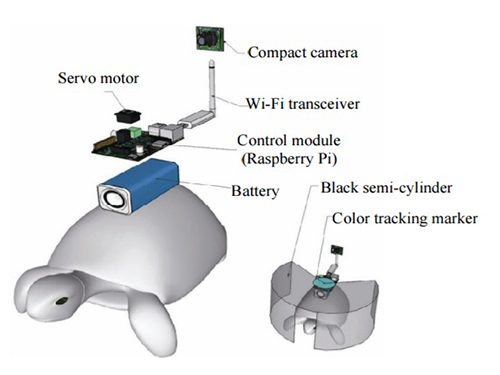 Controlling Turtle Motion with Human Thought
KAIST researchers have developed a technology that can remotely control an animal’s movement with human thought.
In the 2009 blockbuster “Avatar,” a human remotely controls the body of an alien. It does so by injecting human intelligence into a remotely located, biological body. Although still in the realm of science fiction, researchers are nevertheless developing so-called ‘brain-computer interfaces’ (BCIs) following recent advances in electronics and computing. These technologies can ‘read’ and use human thought to control machines, for example, humanoid robots.
New research has demonstrated the possibility of combining a BCI with a device that transmits information from a computer to a brain, or known as a ‘computer-to-brain interface’ (CBI). The combination of these devices could be used to establish a functional link between the brains of different species. Now, researchers from the Korea Advanced Institute of Science and Technology (KAIST) have developed a human-turtle interaction system in which a signal originating from a human brain can affect where a turtle moves.
Unlike previous research that has tried to control animal movement by applying invasive methods, most notably in insects, Professors Phill-Seung Lee of the Mechanical Engineering Department and Sungho Jo of the Computing School propose a conceptual system that can guide an animal’s moving path by controlling its instinctive escape behavior. They chose a turtle because of its cognitive abilities as well as its ability to distinguish different wavelengths of light. Specifically, turtles can recognize a white light source as an open space and so move toward it. They also show specific avoidance behavior to things that might obstruct their view. Turtles also move toward and away from obstacles in their environment in a predictable manner. It was this instinctive, predictable behavior that the researchers induced using the BCI.
The entire human-turtle setup is as follows: A head-mounted display (HMD) is combined with a BCI to immerse the human user in the turtle’s environment. The human operator wears the BCI-HMD system, while the turtle has a 'cyborg system'—consisting of a camera, Wi-Fi transceiver, computer control module, and battery—all mounted on the turtle’s upper shell. Also included on the turtle’s shell is a black semi-cylinder with a slit, which forms the ‘stimulation device.’ This can be turned ±36 degrees via the BCI.
The entire process works like this: the human operator receives images from the camera mounted on the turtle. These real-time video images allow the human operator to decide where the turtle should move. The human provides thought commands that are recognized by the wearable BCI system as electroencephalography (EEG) signals. The BCI can distinguish between three mental states: left, right, and idle. The left and right commands activate the turtle’s stimulation device via Wi-Fi, turning it so that it obstructs the turtle’s view. This invokes its natural instinct to move toward light and change its direction. Finally, the human acquires updated visual feedback from the camera mounted on the shell and in this way continues to remotely navigate the turtle’s trajectory.
The research demonstrates that the animal guiding scheme via BCI can be used in a variety of environments with turtles moving indoors and outdoors on many different surfaces, like gravel and grass, and tackling a range of obstacles, such as shallow water and trees. This technology could be developed to integrate positioning systems and improved augmented and virtual reality techniques, enabling various applications, including devices for military reconnaissance and surveillance.
***
Reference: “Remote Navigation of Turtle by Controlling Instinct Behavior via Human Brain-computer Interface,” Journal of Bionic Engineering, July 2016 (DOI: 10.1016/S1672-6529(16)60322-0)
Depiction of Cyborg System
A human controller influences the turtle’s escape behavior by sending left and right signals via Wi-Fi to a control system on the back of the turtle.
2017.02.21 View 15887
Controlling Turtle Motion with Human Thought
KAIST researchers have developed a technology that can remotely control an animal’s movement with human thought.
In the 2009 blockbuster “Avatar,” a human remotely controls the body of an alien. It does so by injecting human intelligence into a remotely located, biological body. Although still in the realm of science fiction, researchers are nevertheless developing so-called ‘brain-computer interfaces’ (BCIs) following recent advances in electronics and computing. These technologies can ‘read’ and use human thought to control machines, for example, humanoid robots.
New research has demonstrated the possibility of combining a BCI with a device that transmits information from a computer to a brain, or known as a ‘computer-to-brain interface’ (CBI). The combination of these devices could be used to establish a functional link between the brains of different species. Now, researchers from the Korea Advanced Institute of Science and Technology (KAIST) have developed a human-turtle interaction system in which a signal originating from a human brain can affect where a turtle moves.
Unlike previous research that has tried to control animal movement by applying invasive methods, most notably in insects, Professors Phill-Seung Lee of the Mechanical Engineering Department and Sungho Jo of the Computing School propose a conceptual system that can guide an animal’s moving path by controlling its instinctive escape behavior. They chose a turtle because of its cognitive abilities as well as its ability to distinguish different wavelengths of light. Specifically, turtles can recognize a white light source as an open space and so move toward it. They also show specific avoidance behavior to things that might obstruct their view. Turtles also move toward and away from obstacles in their environment in a predictable manner. It was this instinctive, predictable behavior that the researchers induced using the BCI.
The entire human-turtle setup is as follows: A head-mounted display (HMD) is combined with a BCI to immerse the human user in the turtle’s environment. The human operator wears the BCI-HMD system, while the turtle has a 'cyborg system'—consisting of a camera, Wi-Fi transceiver, computer control module, and battery—all mounted on the turtle’s upper shell. Also included on the turtle’s shell is a black semi-cylinder with a slit, which forms the ‘stimulation device.’ This can be turned ±36 degrees via the BCI.
The entire process works like this: the human operator receives images from the camera mounted on the turtle. These real-time video images allow the human operator to decide where the turtle should move. The human provides thought commands that are recognized by the wearable BCI system as electroencephalography (EEG) signals. The BCI can distinguish between three mental states: left, right, and idle. The left and right commands activate the turtle’s stimulation device via Wi-Fi, turning it so that it obstructs the turtle’s view. This invokes its natural instinct to move toward light and change its direction. Finally, the human acquires updated visual feedback from the camera mounted on the shell and in this way continues to remotely navigate the turtle’s trajectory.
The research demonstrates that the animal guiding scheme via BCI can be used in a variety of environments with turtles moving indoors and outdoors on many different surfaces, like gravel and grass, and tackling a range of obstacles, such as shallow water and trees. This technology could be developed to integrate positioning systems and improved augmented and virtual reality techniques, enabling various applications, including devices for military reconnaissance and surveillance.
***
Reference: “Remote Navigation of Turtle by Controlling Instinct Behavior via Human Brain-computer Interface,” Journal of Bionic Engineering, July 2016 (DOI: 10.1016/S1672-6529(16)60322-0)
Depiction of Cyborg System
A human controller influences the turtle’s escape behavior by sending left and right signals via Wi-Fi to a control system on the back of the turtle.
2017.02.21 View 15887 -
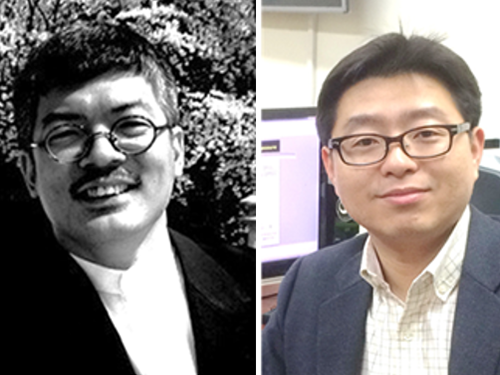 Professor Shin Honored Posthumously for Iridescent Microparticles
(The Late Professor Joong-Hoon Shin (left) and Professor Shin-Hyun Kim)
A research team co-led by Professor Shin-Hyun Kim from the Department of Chemical and Biomolecular Engineering and Professor Jong-Ryul Jeong from the Department of Materials Science and Engineering at Chungnam National University developed iridescent microparticles with a structural color gradient. The research team posthumously dedicated their research to a renowned professor in the field of nanophotonics, the late Professor Joong-Hoon Shin of the Graduate School of Nanoscience and Technology at KAIST. He passed away suddenly in a car accident last September.
The iridescent microparticles, which allow on-demand control over structural color, will be key components for next-generation reflection-mode displays with clear color realization even in direct sunlight.
Materials such as opals, Morpho butterfly wings, and peacock feathers all display beautiful colors without pigment, using regularly-spaced nanostructures. Regularly-spaced nanostructures render color, by selectively reflecting the light of a particular wave through light interference. As such, materials that possess periodic modulation of refractive index at subwavelength scale are referred to as photonic crystals.
In general, photonic crystals are only able to display a single color, so limitations exist when attempting to apply them to reflection-mode displays which call for multiple structural colors. The research team addressed the issue using inspiration from snowflakes stacking in the winter. When snow falls on the surface of a round-shaped structure, the thickness of the snow stacking differs depending on the orientation. Based on this observation, the research team created photonic microparticles with a structural color gradient by depositing two different materials on spherical microparticles.
When some material is deposited on the surface of a sphere, the material on the top is thickest and becomes thinner on the sides. The team alternately deposited titania and silica on the spherical microparticles to form periodic modulation of the refractive index. The thickness of the alternating photonic layers is reduced along the angle from the top, which yields a structural color gradient.
Consequently, the microparticles reflect long-wavelength red light from the top of the sphere and short-wavelength blue light from the side of the sphere. Any color of the visible spectrum can be selected in between the top and side depending on the orientation of the microparticles.
The research team used an external magnetic field as a way to control the orientation of the photonic microparticles and the structural colors. As magnetic iron layer was deposited underneath the alternating photonic layer, it was possible to freely control the orientation of the microparticles using a magnet, thereby allowing control of the color seen by the users.
KAIST doctoral candidate Seung Yeol Lee of the Department of Chemical and Biomolecular Engineering is the first author of this research, with support from the Midcareer Researcher Program of the National Research Foundation and funded by the Ministry of Science, ICT, and Future Planning (MSIP). This research was published in the online edition of Advanced Materials on February 6, 2017.
Figure1: Sets of an OM image of photonic Janus microspheres and an SEM image showing a cross-section of the photonic layers.
Figure 2: A series of schematics and OM images showing the color change depending on the orientation angle of the photonic Janus microsphere.
2017.02.17 View 9200
Professor Shin Honored Posthumously for Iridescent Microparticles
(The Late Professor Joong-Hoon Shin (left) and Professor Shin-Hyun Kim)
A research team co-led by Professor Shin-Hyun Kim from the Department of Chemical and Biomolecular Engineering and Professor Jong-Ryul Jeong from the Department of Materials Science and Engineering at Chungnam National University developed iridescent microparticles with a structural color gradient. The research team posthumously dedicated their research to a renowned professor in the field of nanophotonics, the late Professor Joong-Hoon Shin of the Graduate School of Nanoscience and Technology at KAIST. He passed away suddenly in a car accident last September.
The iridescent microparticles, which allow on-demand control over structural color, will be key components for next-generation reflection-mode displays with clear color realization even in direct sunlight.
Materials such as opals, Morpho butterfly wings, and peacock feathers all display beautiful colors without pigment, using regularly-spaced nanostructures. Regularly-spaced nanostructures render color, by selectively reflecting the light of a particular wave through light interference. As such, materials that possess periodic modulation of refractive index at subwavelength scale are referred to as photonic crystals.
In general, photonic crystals are only able to display a single color, so limitations exist when attempting to apply them to reflection-mode displays which call for multiple structural colors. The research team addressed the issue using inspiration from snowflakes stacking in the winter. When snow falls on the surface of a round-shaped structure, the thickness of the snow stacking differs depending on the orientation. Based on this observation, the research team created photonic microparticles with a structural color gradient by depositing two different materials on spherical microparticles.
When some material is deposited on the surface of a sphere, the material on the top is thickest and becomes thinner on the sides. The team alternately deposited titania and silica on the spherical microparticles to form periodic modulation of the refractive index. The thickness of the alternating photonic layers is reduced along the angle from the top, which yields a structural color gradient.
Consequently, the microparticles reflect long-wavelength red light from the top of the sphere and short-wavelength blue light from the side of the sphere. Any color of the visible spectrum can be selected in between the top and side depending on the orientation of the microparticles.
The research team used an external magnetic field as a way to control the orientation of the photonic microparticles and the structural colors. As magnetic iron layer was deposited underneath the alternating photonic layer, it was possible to freely control the orientation of the microparticles using a magnet, thereby allowing control of the color seen by the users.
KAIST doctoral candidate Seung Yeol Lee of the Department of Chemical and Biomolecular Engineering is the first author of this research, with support from the Midcareer Researcher Program of the National Research Foundation and funded by the Ministry of Science, ICT, and Future Planning (MSIP). This research was published in the online edition of Advanced Materials on February 6, 2017.
Figure1: Sets of an OM image of photonic Janus microspheres and an SEM image showing a cross-section of the photonic layers.
Figure 2: A series of schematics and OM images showing the color change depending on the orientation angle of the photonic Janus microsphere.
2017.02.17 View 9200 -
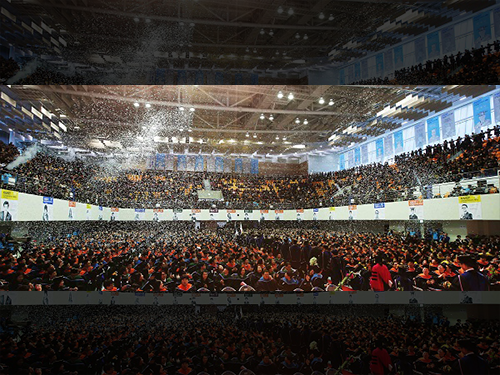 KAIST Celebrates the 2017 Commencement
KAIST hosted its 2017 Commencement, awarding diplomas to 2,767 members of the Class of 2017 during a ceremony on February 17. President Sung-Mo Kang, Minister Yang-hee Choi of Science, ICT, and Future Planning, and Chairman of the KAIST Board of Trustees Jang-Moo Lee joined the ceremony along with the graduates and their family and friends at the Ryu Keun Chul Sports Complex.
The graduating class included 638 Ph.D. degrees, 1,335 Master’s degrees, and 794 Bachelor’s degrees being conferred. Among them, Young-Ki Song from the Department of Electric Engineering was honored to win the Minister’s Award, the highest award bestowed to an undergraduate. The KAIST Presidential Award went to Min-Jae Park of the Department of Mathematical Sciences and the KAIST Board of Trustee Chairman’s Award was presented to Jae-Hyung Cho from the Department of Mechanical Engineering.
Including this year’s graduating class, KAIST has turned out more than 59,000 highly educated science and technology talents including 11,731 Ph.D.s since its foundation in 1971. This year, 24-year-old Seo-Hee Oh earned her Ph.D. in chemistry as the youngest Ph.D. of the year after completing her Master’s and Ph.D. combined course in three years.
President Sung-Mo Kang praised the creativity of this graduating class and their excellent ability in his charge, saying, “As future leaders of our society, you are expected to develop a sense of compassion and outstanding professionalism to contribute to the advancement of not only Korea but also the whole world.’
For full text of President Kang’s charge to the graduates, please click.
2017.02.17 View 10005
KAIST Celebrates the 2017 Commencement
KAIST hosted its 2017 Commencement, awarding diplomas to 2,767 members of the Class of 2017 during a ceremony on February 17. President Sung-Mo Kang, Minister Yang-hee Choi of Science, ICT, and Future Planning, and Chairman of the KAIST Board of Trustees Jang-Moo Lee joined the ceremony along with the graduates and their family and friends at the Ryu Keun Chul Sports Complex.
The graduating class included 638 Ph.D. degrees, 1,335 Master’s degrees, and 794 Bachelor’s degrees being conferred. Among them, Young-Ki Song from the Department of Electric Engineering was honored to win the Minister’s Award, the highest award bestowed to an undergraduate. The KAIST Presidential Award went to Min-Jae Park of the Department of Mathematical Sciences and the KAIST Board of Trustee Chairman’s Award was presented to Jae-Hyung Cho from the Department of Mechanical Engineering.
Including this year’s graduating class, KAIST has turned out more than 59,000 highly educated science and technology talents including 11,731 Ph.D.s since its foundation in 1971. This year, 24-year-old Seo-Hee Oh earned her Ph.D. in chemistry as the youngest Ph.D. of the year after completing her Master’s and Ph.D. combined course in three years.
President Sung-Mo Kang praised the creativity of this graduating class and their excellent ability in his charge, saying, “As future leaders of our society, you are expected to develop a sense of compassion and outstanding professionalism to contribute to the advancement of not only Korea but also the whole world.’
For full text of President Kang’s charge to the graduates, please click.
2017.02.17 View 10005 -
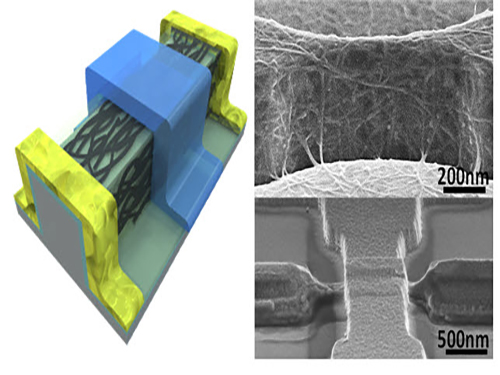 An Improved Carbon Nanotube Semiconductor
Professor Yang-Kyu Choi and his research team of the School of Electrical Engineering at KAIST collaborated with Professor Sung-Jin Choi of Kookmin University to develop a large-scale carbon nanotube semiconductor by using a 3-D fin-gate structure with carbon nanotubes on its top.
Dong Il Lee, a postdoctoral researcher at KAIST’s Electrical Engineering School, participated in this study as the first author. It was published in ACS Nano on November 10, 2016, and was entitled “Three-Dimensional Fin-Structured Semiconducting Carbon Nanotube Network Transistor.”
A semiconductor made with carbon nanotubes operates faster than a silicon semiconductor and requires less energy, yielding higher performance.
Most electronic equipment and devices, however, use silicon semiconductors because it is difficult to fabricate highly purified and densely packed semiconductors with carbon nanotubes (CNTs).
To date, the performance of CNTs was limited due to their low density. Their purity was also low, so it was impossible to make products that had a constant yield on a large-surface wafer or substrate. These characteristics made the mass production of semiconducting CNTs difficult.
To solve these difficulties, the research team used a 3-D fin-gate to vapor-deposit carbon nanotubes on its top. They developed a semiconductor that had a high current density with a width less than 50 nm.
The three-dimensional fin structure was able to vapor-deposit 600 carbon nanotubes per micrometer. This structure could have 20 times more nanotubes than the two dimensional structure, which could only vapor-deposit thirty in the same 1 micrometer width.
In addition, the research team used semi-conductive carbon nanotubes having a purity rating higher than 99.9% from a previous study to obtain a high yield semiconductor.
The semiconductor from the research group has a high current density even with a width less than 50 μm. The new semiconductor is expected to be five times faster than a silicon-based semiconductor and will require five times less electricity during operation.
Furthermore, the new semiconductor can be made by or will be compatible with the equipment for producing silicon-based semiconductors, so there will be no additional costs.
Researcher Lee said, “As a next generation semiconductor, the carbon nanotube semiconductor will have better performance, and its effectiveness will be higher.” He also added, “Hopefully, the new semiconductor will replace the silicon-based semiconductors in ten years.”
This study received support from the Center for Integrated Smart Sensors funded by the Ministry of Science, ICT & Future Planning of Korea as the Global Frontier Project, and from the CMOS (Complementary Metal-Oxide-Semiconductor) THz Technology Convergence Center of the Pioneer Research Center Program sponsored by the National Research Foundation of Korea.
Picture 1: 3D Diagram of the Carbon Nanotube Electronic Device and Its Scanning Electron Microscope (SEM) Image
Picture 2: 3D Transistor Device on an 8-inch Base and the SEM Image of Its Cross Section
2017.02.16 View 11823
An Improved Carbon Nanotube Semiconductor
Professor Yang-Kyu Choi and his research team of the School of Electrical Engineering at KAIST collaborated with Professor Sung-Jin Choi of Kookmin University to develop a large-scale carbon nanotube semiconductor by using a 3-D fin-gate structure with carbon nanotubes on its top.
Dong Il Lee, a postdoctoral researcher at KAIST’s Electrical Engineering School, participated in this study as the first author. It was published in ACS Nano on November 10, 2016, and was entitled “Three-Dimensional Fin-Structured Semiconducting Carbon Nanotube Network Transistor.”
A semiconductor made with carbon nanotubes operates faster than a silicon semiconductor and requires less energy, yielding higher performance.
Most electronic equipment and devices, however, use silicon semiconductors because it is difficult to fabricate highly purified and densely packed semiconductors with carbon nanotubes (CNTs).
To date, the performance of CNTs was limited due to their low density. Their purity was also low, so it was impossible to make products that had a constant yield on a large-surface wafer or substrate. These characteristics made the mass production of semiconducting CNTs difficult.
To solve these difficulties, the research team used a 3-D fin-gate to vapor-deposit carbon nanotubes on its top. They developed a semiconductor that had a high current density with a width less than 50 nm.
The three-dimensional fin structure was able to vapor-deposit 600 carbon nanotubes per micrometer. This structure could have 20 times more nanotubes than the two dimensional structure, which could only vapor-deposit thirty in the same 1 micrometer width.
In addition, the research team used semi-conductive carbon nanotubes having a purity rating higher than 99.9% from a previous study to obtain a high yield semiconductor.
The semiconductor from the research group has a high current density even with a width less than 50 μm. The new semiconductor is expected to be five times faster than a silicon-based semiconductor and will require five times less electricity during operation.
Furthermore, the new semiconductor can be made by or will be compatible with the equipment for producing silicon-based semiconductors, so there will be no additional costs.
Researcher Lee said, “As a next generation semiconductor, the carbon nanotube semiconductor will have better performance, and its effectiveness will be higher.” He also added, “Hopefully, the new semiconductor will replace the silicon-based semiconductors in ten years.”
This study received support from the Center for Integrated Smart Sensors funded by the Ministry of Science, ICT & Future Planning of Korea as the Global Frontier Project, and from the CMOS (Complementary Metal-Oxide-Semiconductor) THz Technology Convergence Center of the Pioneer Research Center Program sponsored by the National Research Foundation of Korea.
Picture 1: 3D Diagram of the Carbon Nanotube Electronic Device and Its Scanning Electron Microscope (SEM) Image
Picture 2: 3D Transistor Device on an 8-inch Base and the SEM Image of Its Cross Section
2017.02.16 View 11823 -
 New Building Endowed in Bio and Brain Engineering Department
An endowment from the former Chairman of Mirae Industries, Moon Soul Chung, was used to establish the Yang Bun Soon Building in the Bio and Brain Engineering Department at KAIST. The opening ceremony for the building took place on February 8 and was attended by President Sung-Mo Kang, KAIST administrators, faculty, and students.
The Yang Bun Soon Building, named after the wife of Chairman Chung, is a new addition to the Bio and Brain Engineering Department complex. The five-story building was erected next to the 11-story Chung Moon Soul Building, which was completed in 2003 using a portion of his first endowment to KAIST. Chairman Chung donated approximately 30 billion KRW for funding a convergence research for IT and BT in 2001.
The new building was completed with financing from Chung’s second endowment of 21.5 billion KRW in support of the fields of brain and cognitive sciences in 2014. The building will accommodate both lab facilities and lecture halls.
At the ceremony, President Kang thanked the Chungs for their continuing generosity to KAIST. He commended Chung for showing how entrepreneurs can fulfill their social responsibility by supporting Korea’s future through donations and support.
(Photo caption: Chung Moon Soul Building (left) and Yang Bun Soon Building(right))
2017.02.09 View 6501
New Building Endowed in Bio and Brain Engineering Department
An endowment from the former Chairman of Mirae Industries, Moon Soul Chung, was used to establish the Yang Bun Soon Building in the Bio and Brain Engineering Department at KAIST. The opening ceremony for the building took place on February 8 and was attended by President Sung-Mo Kang, KAIST administrators, faculty, and students.
The Yang Bun Soon Building, named after the wife of Chairman Chung, is a new addition to the Bio and Brain Engineering Department complex. The five-story building was erected next to the 11-story Chung Moon Soul Building, which was completed in 2003 using a portion of his first endowment to KAIST. Chairman Chung donated approximately 30 billion KRW for funding a convergence research for IT and BT in 2001.
The new building was completed with financing from Chung’s second endowment of 21.5 billion KRW in support of the fields of brain and cognitive sciences in 2014. The building will accommodate both lab facilities and lecture halls.
At the ceremony, President Kang thanked the Chungs for their continuing generosity to KAIST. He commended Chung for showing how entrepreneurs can fulfill their social responsibility by supporting Korea’s future through donations and support.
(Photo caption: Chung Moon Soul Building (left) and Yang Bun Soon Building(right))
2017.02.09 View 6501 -
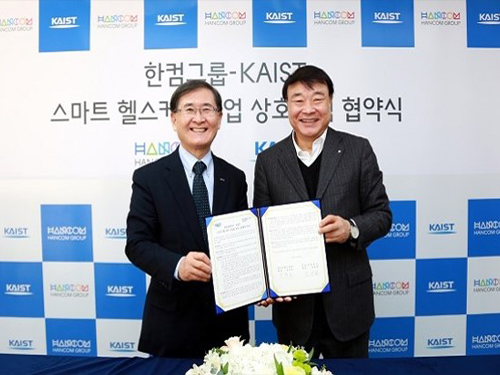 Dr.M Drives Smart Healthcare Industry in Partnership with Hancom
President Sung-Mo Kang signed an agreement on January 25 with Hancom Group Chairman Sang Chul Kim to establish a smart healthcare complex in Gapyeong, Kyonggido. With the Gapyeong complex launch, KAIST will come to commercialize Dr. M system along with other Dr.M consortium members as a new growth engine to drive the smart health industry.
Dr. M is a smart healthcare platform developed by the Health Science Research Institute at KAIST in 2014. Dr. M is capable of analyzing and predicting diseases, as well as prescribing, by incorporating ICT and medical technologies. Dr. M applies diverse technologies such as healthcare sensors, wearable devices, low-power communications technology, and cloud and big data collection platforms.
Hancom Group, a leading computer software company in Korea, has participated in the project since 2015 for advancing the smart healthcare market by developing mobile healthcare software program. Hancom joined the Dr.M consortium launched last November.
(President Kang (left) poses with Hancom Chairman Kim after signing.)
2017.02.03 View 7405
Dr.M Drives Smart Healthcare Industry in Partnership with Hancom
President Sung-Mo Kang signed an agreement on January 25 with Hancom Group Chairman Sang Chul Kim to establish a smart healthcare complex in Gapyeong, Kyonggido. With the Gapyeong complex launch, KAIST will come to commercialize Dr. M system along with other Dr.M consortium members as a new growth engine to drive the smart health industry.
Dr. M is a smart healthcare platform developed by the Health Science Research Institute at KAIST in 2014. Dr. M is capable of analyzing and predicting diseases, as well as prescribing, by incorporating ICT and medical technologies. Dr. M applies diverse technologies such as healthcare sensors, wearable devices, low-power communications technology, and cloud and big data collection platforms.
Hancom Group, a leading computer software company in Korea, has participated in the project since 2015 for advancing the smart healthcare market by developing mobile healthcare software program. Hancom joined the Dr.M consortium launched last November.
(President Kang (left) poses with Hancom Chairman Kim after signing.)
2017.02.03 View 7405 -
 A New Approach to 3D Holographic Displays Greatly Improves the Image Quality
With the addition of holographic diffusers or frosted glasses to wavefront modulators, KAIST researchers offer a simple and practical solution to significantly enhance the performance of 3D dynamic holographic displays by 2,600 times.
The potential applications of three-dimensional (3D) digital holograms are enormous. In addition to arts and entertainment, various fields including biomedical imaging, scientific visualization, engineering design, and displays could benefit from this technology. For example, creating full-sized organs for 3D analysis by doctors could be helpful, but it remained a challenge owing to the limitation of hologram-generation techniques.
A research team led by Professor YongKeun Park of the Physics Department at KAIST has come up with a solution and developed a 3D holographic display that performs more than 2,600 times better than existing 3D holographic displays. This study is expected to improve the limited size and viewing angle of 3D images, which were a major problem of the current holographic displays. The study was published online in Nature Photonics on January 23, 2017.
3D holograms, which often appear in science fiction films, are a familiar technology to the public, but holograms in movies are created with computer graphic effects. Methods for creating true 3D holograms are still being studied in the laboratory. For example, due to the difficulty of generating real 3D images, recent virtual reality (VR) and augmented reality (AR) devices project two different two-dimensional (2D) images onto a viewer to induce optical illusions.
To create a 3D hologram that can be viewed without special equipment such as 3D glasses, the wavefront of light must be controlled using wavefront modulators such as spatial light modulators (SLMs) and deformable mirrors (DMs). A wavefront modulator is an optical manipulation device that can control the direction of light propagation.
However, the biggest limitation to using these modulators as 3D displays is the number of pixels. The large number of pixels that are packed into high-resolution displays developed in recent years are suitable for a 2D image, and the amount of information contained in those pixels cannot produce a 3D image. For this reason, a 3D image that can be made with existing wavefront modulator technology is 1 cm in size with a narrow viewing angle of 3 degrees, which is far from practicable.
As an alternative, KAIST researchers used a DM and added two successive holographic diffusers to scatter light. By scattering light in many directions, this allows for a wider viewing angle and larger image, but results in volume speckle fields, which are caused by the interference of multiple scattered light. Random volume speckle fields cannot be used to display 3D images.
To fix the problem, the researchers employed a wavefront-shaping technique to control the fields. As a result, they succeeded in producing an enhanced 3D holographic image with a viewing angle of 35 degrees in a volume of 2 cm in length, width, and height. This yielded a performance that was about 2,600 times stronger than the original image definition generated when they used a DM without a diffuser.
Professor Park said, “Scattering light has previously been believed to interfere with the recognition of objects, but we have demonstrated that current 3D displays can be improved significantly with an increased viewing angle and image size by properly controlling the scattered light.”
Hyeonseung Yu, who is the lead author of this research article and a doctoral candidate in the Department of Physics, KAIST, noted that this technology signals a good start to develop a practical model for dynamic 3D hologram displays that can be enjoyed without the need for special eyeglasses. “This approach can also be applied to AR and VR technology to enhance the image resolution and viewing angles,” added Yu.
The research paper is entitled “Ultrahigh-definition Dynamic 3D Holographic Display by Active Control of Volume Speckle Fields.”
Figure 1. Concept of Scattering Display
The size and viewing angle of 3D images can be simultaneously increased when a scattering medium (diffuser) is introduced. By controlling the wavefront impinging on the scattering medium, the desired 3D hologram is generated.
Figure 2. Experimental Setup
The optical set-up consists of a deformable mirror and the scattering medium with two successive holographic diffusers. A high-numerical-aperture imaging unit mounted on a three-axis motorized translational system is utilized for wavefront optimization and imaging.
Figure 3. 3D Images Projected
This picture shows 3D images in a volume of 2 cm × 2 cm × 2 cm with a viewing angle of 35 degrees using one of the wavefront modulators, a digital micromirror device (DMD).
Figure 4. Artist’s Rendition of the Proposed Concept
A dynamic 3D hologram of a face is displayed.
2017.02.01 View 14214
A New Approach to 3D Holographic Displays Greatly Improves the Image Quality
With the addition of holographic diffusers or frosted glasses to wavefront modulators, KAIST researchers offer a simple and practical solution to significantly enhance the performance of 3D dynamic holographic displays by 2,600 times.
The potential applications of three-dimensional (3D) digital holograms are enormous. In addition to arts and entertainment, various fields including biomedical imaging, scientific visualization, engineering design, and displays could benefit from this technology. For example, creating full-sized organs for 3D analysis by doctors could be helpful, but it remained a challenge owing to the limitation of hologram-generation techniques.
A research team led by Professor YongKeun Park of the Physics Department at KAIST has come up with a solution and developed a 3D holographic display that performs more than 2,600 times better than existing 3D holographic displays. This study is expected to improve the limited size and viewing angle of 3D images, which were a major problem of the current holographic displays. The study was published online in Nature Photonics on January 23, 2017.
3D holograms, which often appear in science fiction films, are a familiar technology to the public, but holograms in movies are created with computer graphic effects. Methods for creating true 3D holograms are still being studied in the laboratory. For example, due to the difficulty of generating real 3D images, recent virtual reality (VR) and augmented reality (AR) devices project two different two-dimensional (2D) images onto a viewer to induce optical illusions.
To create a 3D hologram that can be viewed without special equipment such as 3D glasses, the wavefront of light must be controlled using wavefront modulators such as spatial light modulators (SLMs) and deformable mirrors (DMs). A wavefront modulator is an optical manipulation device that can control the direction of light propagation.
However, the biggest limitation to using these modulators as 3D displays is the number of pixels. The large number of pixels that are packed into high-resolution displays developed in recent years are suitable for a 2D image, and the amount of information contained in those pixels cannot produce a 3D image. For this reason, a 3D image that can be made with existing wavefront modulator technology is 1 cm in size with a narrow viewing angle of 3 degrees, which is far from practicable.
As an alternative, KAIST researchers used a DM and added two successive holographic diffusers to scatter light. By scattering light in many directions, this allows for a wider viewing angle and larger image, but results in volume speckle fields, which are caused by the interference of multiple scattered light. Random volume speckle fields cannot be used to display 3D images.
To fix the problem, the researchers employed a wavefront-shaping technique to control the fields. As a result, they succeeded in producing an enhanced 3D holographic image with a viewing angle of 35 degrees in a volume of 2 cm in length, width, and height. This yielded a performance that was about 2,600 times stronger than the original image definition generated when they used a DM without a diffuser.
Professor Park said, “Scattering light has previously been believed to interfere with the recognition of objects, but we have demonstrated that current 3D displays can be improved significantly with an increased viewing angle and image size by properly controlling the scattered light.”
Hyeonseung Yu, who is the lead author of this research article and a doctoral candidate in the Department of Physics, KAIST, noted that this technology signals a good start to develop a practical model for dynamic 3D hologram displays that can be enjoyed without the need for special eyeglasses. “This approach can also be applied to AR and VR technology to enhance the image resolution and viewing angles,” added Yu.
The research paper is entitled “Ultrahigh-definition Dynamic 3D Holographic Display by Active Control of Volume Speckle Fields.”
Figure 1. Concept of Scattering Display
The size and viewing angle of 3D images can be simultaneously increased when a scattering medium (diffuser) is introduced. By controlling the wavefront impinging on the scattering medium, the desired 3D hologram is generated.
Figure 2. Experimental Setup
The optical set-up consists of a deformable mirror and the scattering medium with two successive holographic diffusers. A high-numerical-aperture imaging unit mounted on a three-axis motorized translational system is utilized for wavefront optimization and imaging.
Figure 3. 3D Images Projected
This picture shows 3D images in a volume of 2 cm × 2 cm × 2 cm with a viewing angle of 35 degrees using one of the wavefront modulators, a digital micromirror device (DMD).
Figure 4. Artist’s Rendition of the Proposed Concept
A dynamic 3D hologram of a face is displayed.
2017.02.01 View 14214 -
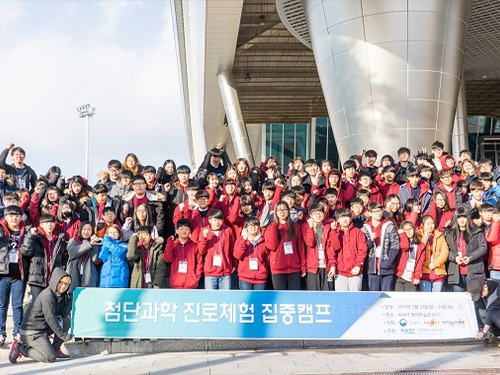 KAIST Intensive Science Camp for Middle-High School Students
The KAIST Global Institute of Talented Education (Director: Dong-Soo Kwon) invited around 90 middle and high school students for an advanced science intensive camp from January 22 to 24.
This camp targeted middle and high school students in community centers or child-care institutions. It aims to increase students’ interest in science and engineering, and assist them with their career paths through programs such as special lectures on science, advanced science projects, and career mentoring.
Participating students were divided into groups of seven or eight with a KAIST student as a mentor to conduct advanced science projects such as VR controller production and robot arm programming. The camp included exploring future career options and science and engineering college admission counselling.
Jiyoung Ryu, Research Professor for the KAIST Global Institute of Talented Education, said, “KAIST started the science and engineering career experience program in 2016 with the Ministry of Education and Korea Research Institute for Vocational Education and Training (KRIVET). So far, 6000 middle and high school students from around the country have participated. The camp is more meaningful since it educates students in social responsibility, in addition to the fields of science and engineering, both of which are missions and goals that KAIST strives for.” She continued to say, “We plan to continue to expand the program in the future.”
The KAIST Global Institute of Talented Education is actively conducting research and projects on national education for talented youth such as policy research concerning gifted education, science and engineering career education, advanced science camps, training for gifted education teachers, and cyber gifted education programs.
2017.02.01 View 9177
KAIST Intensive Science Camp for Middle-High School Students
The KAIST Global Institute of Talented Education (Director: Dong-Soo Kwon) invited around 90 middle and high school students for an advanced science intensive camp from January 22 to 24.
This camp targeted middle and high school students in community centers or child-care institutions. It aims to increase students’ interest in science and engineering, and assist them with their career paths through programs such as special lectures on science, advanced science projects, and career mentoring.
Participating students were divided into groups of seven or eight with a KAIST student as a mentor to conduct advanced science projects such as VR controller production and robot arm programming. The camp included exploring future career options and science and engineering college admission counselling.
Jiyoung Ryu, Research Professor for the KAIST Global Institute of Talented Education, said, “KAIST started the science and engineering career experience program in 2016 with the Ministry of Education and Korea Research Institute for Vocational Education and Training (KRIVET). So far, 6000 middle and high school students from around the country have participated. The camp is more meaningful since it educates students in social responsibility, in addition to the fields of science and engineering, both of which are missions and goals that KAIST strives for.” She continued to say, “We plan to continue to expand the program in the future.”
The KAIST Global Institute of Talented Education is actively conducting research and projects on national education for talented youth such as policy research concerning gifted education, science and engineering career education, advanced science camps, training for gifted education teachers, and cyber gifted education programs.
2017.02.01 View 9177 -
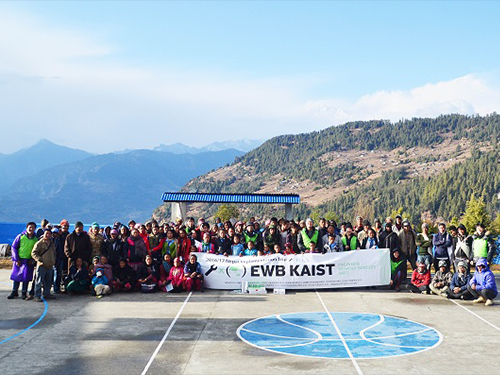 EWB-KAIST Wraps up Five-Year Project in Nepal
‘Engineers Without Borders-KAIST (EWB-KAIST)’ led by Professor Tae-ho Song from the Department of Mechanical Engineering returned to Korea on January 10 after a two-week project in Nangi, Nepal.
EWB-KAIST was established in 2012 by KAIST students and professors. Since then, the team visited Nangi, in the Annapurna region of Nepal, to engage in Appropriate Technology (AT) development projects. The projects included building passive houses and small hydroelectric power, and teaching science education. In particular, passive houses that use straw as an insulator received great a reception from the locals.
This was their last visit to Nepal, since the five-year project has now come to an end. Future projects in Mongolia will be led by Professor Buhm Soon Park from the Graduate School of Science and Technology Policy.
Professor Song commented, “I am glad that the Nepal project was successfully conducted over the last five years. To make sure the support does not end here, I will personally continue to visit the Himalayas to assist the villagers.”
EWB-KAIST is a non-profit organization that conducts activities with the aim of AT development and providing support for less-developed countries in need of the benefits of technology.
( Passive house made of straws by EWB-KAIST team in Nangi, Nepal.)
2017.02.01 View 8248
EWB-KAIST Wraps up Five-Year Project in Nepal
‘Engineers Without Borders-KAIST (EWB-KAIST)’ led by Professor Tae-ho Song from the Department of Mechanical Engineering returned to Korea on January 10 after a two-week project in Nangi, Nepal.
EWB-KAIST was established in 2012 by KAIST students and professors. Since then, the team visited Nangi, in the Annapurna region of Nepal, to engage in Appropriate Technology (AT) development projects. The projects included building passive houses and small hydroelectric power, and teaching science education. In particular, passive houses that use straw as an insulator received great a reception from the locals.
This was their last visit to Nepal, since the five-year project has now come to an end. Future projects in Mongolia will be led by Professor Buhm Soon Park from the Graduate School of Science and Technology Policy.
Professor Song commented, “I am glad that the Nepal project was successfully conducted over the last five years. To make sure the support does not end here, I will personally continue to visit the Himalayas to assist the villagers.”
EWB-KAIST is a non-profit organization that conducts activities with the aim of AT development and providing support for less-developed countries in need of the benefits of technology.
( Passive house made of straws by EWB-KAIST team in Nangi, Nepal.)
2017.02.01 View 8248 -
 Educating for Sustainability: KAIST's Graduate Schools of EEWS and Green Growth
At the World Economic Forum’s (WEF) Annual Meeting (Davos Forum) January 17-20, 2017 in Davos, Switzerland, the International Sustainable Campus Network (ISCN) and the Global University Leaders Forum (GULF) shared exemplary case studies for teaching “sustainability” on campuses, which were implemented by 30 leading universities around the world.
KAIST President Sung-Mo Kang participated in the meeting and introduced two of the university’s graduate schools and their main activities in 2016: The Graduate School of EEWS (energy, environment, water and sustainability) and The Graduate School of Green Growth.
President Kang explained that the EEWS Graduate School, created in 2009, represents KAIST’s commitment to interdisciplinary education and research, addressing key issues of today’s global challenges including energy, environment, and water for a sustainable society. The graduate school hosted its first international forum last October, “The EEWS 2016: Progress and Perspective of Energy Science and Technology.” Over 200 participants from Korea and across the world discussed and learned about recent advances, challenges, and future opportunities in energy science and technology, such as the development of sustainable energy harvesting and storage, catalytic energy conversion technology, green chemical materials, and photocatalytic systems for sustainable water treatment.
He also presented the Green Growth Graduate School as KAIST’s initiative to a build global alliance for sustainable growth. Established in 2013 in the College of Business, the graduate school provides world-class education and research on green business, finance, and policy. Among many international conferences and workshops it hosts, the school has held the Seoul Climate Energy Conference annually since 2014. Last year alone, over 400 international participants including climate and energy policy makers and scholars gathered at the conference and strengthened partnerships with the global community. The school has been an active member of international organizations that advocate for green economies and sustainable development, the Global Green Growth Institute and the United Nations Environment Programme, for example.
President Kang noted that KAIST has been at the forefront of formulating and implementing holistic and cross-disciplinary approaches to foster learning and research environments in which university members can take on global issues, which are critical to humanity and our ecosystem, and work toward a more sustainable future.
Founded in 2007, the ISCN is a non-profit association of globally-leading colleges and universities representing over 30 countries and working together to holistically integrate sustainability into campus operations, research, and teaching.
Created in 2006, the GULF is one of the WEF’s expert communities, which consists of top leaders from 26 global universities, including the University of Cambridge, Peking University, Stanford University, and the Swiss Federal Institute of Technology in Zurich. The GULF offers in-depth discussions and exchange of ideas on the future of higher education and the role of science in society. Since 2012, KAIST has been a member of GULF, the only university from Korea.
The ISCN and GULF have held a meeting each year at the Davos Forum since 2011 to share information, insights, and best practices for achieving sustainable campus operations and integrating sustainability into research and teaching.
To see the full report on the 2017 WEF ISCN-GULF case studies, please go to
http://www.international-sustainable-campus-network.org/downloads/general/462-educating-for-sustainability/file.
2017.01.25 View 9933
Educating for Sustainability: KAIST's Graduate Schools of EEWS and Green Growth
At the World Economic Forum’s (WEF) Annual Meeting (Davos Forum) January 17-20, 2017 in Davos, Switzerland, the International Sustainable Campus Network (ISCN) and the Global University Leaders Forum (GULF) shared exemplary case studies for teaching “sustainability” on campuses, which were implemented by 30 leading universities around the world.
KAIST President Sung-Mo Kang participated in the meeting and introduced two of the university’s graduate schools and their main activities in 2016: The Graduate School of EEWS (energy, environment, water and sustainability) and The Graduate School of Green Growth.
President Kang explained that the EEWS Graduate School, created in 2009, represents KAIST’s commitment to interdisciplinary education and research, addressing key issues of today’s global challenges including energy, environment, and water for a sustainable society. The graduate school hosted its first international forum last October, “The EEWS 2016: Progress and Perspective of Energy Science and Technology.” Over 200 participants from Korea and across the world discussed and learned about recent advances, challenges, and future opportunities in energy science and technology, such as the development of sustainable energy harvesting and storage, catalytic energy conversion technology, green chemical materials, and photocatalytic systems for sustainable water treatment.
He also presented the Green Growth Graduate School as KAIST’s initiative to a build global alliance for sustainable growth. Established in 2013 in the College of Business, the graduate school provides world-class education and research on green business, finance, and policy. Among many international conferences and workshops it hosts, the school has held the Seoul Climate Energy Conference annually since 2014. Last year alone, over 400 international participants including climate and energy policy makers and scholars gathered at the conference and strengthened partnerships with the global community. The school has been an active member of international organizations that advocate for green economies and sustainable development, the Global Green Growth Institute and the United Nations Environment Programme, for example.
President Kang noted that KAIST has been at the forefront of formulating and implementing holistic and cross-disciplinary approaches to foster learning and research environments in which university members can take on global issues, which are critical to humanity and our ecosystem, and work toward a more sustainable future.
Founded in 2007, the ISCN is a non-profit association of globally-leading colleges and universities representing over 30 countries and working together to holistically integrate sustainability into campus operations, research, and teaching.
Created in 2006, the GULF is one of the WEF’s expert communities, which consists of top leaders from 26 global universities, including the University of Cambridge, Peking University, Stanford University, and the Swiss Federal Institute of Technology in Zurich. The GULF offers in-depth discussions and exchange of ideas on the future of higher education and the role of science in society. Since 2012, KAIST has been a member of GULF, the only university from Korea.
The ISCN and GULF have held a meeting each year at the Davos Forum since 2011 to share information, insights, and best practices for achieving sustainable campus operations and integrating sustainability into research and teaching.
To see the full report on the 2017 WEF ISCN-GULF case studies, please go to
http://www.international-sustainable-campus-network.org/downloads/general/462-educating-for-sustainability/file.
2017.01.25 View 9933 -
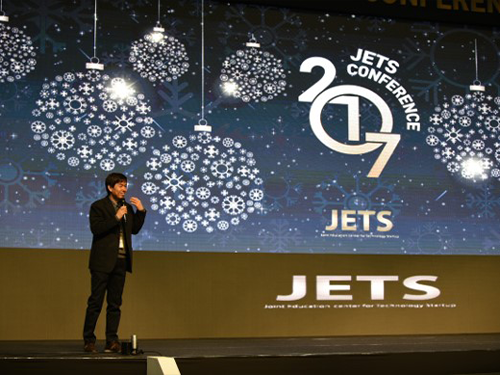 JETS Conference 2017
KAIST and four science and technology research universities in Korea co-hosted a technology start-up fair, the 2017 JETS (Job, Exhibition, Tech Forum, and Startup) Conference January 19 ~20 in the Ryu Geun-chul Sports Complex at KAIST.
Korea’s major science and technology research universities, Daegu Gyeongbuk Institute of Science and Technology (DGIST), Gwangju Institute of Science and Technology (GIST), Pohang University of Science and Technology (Postech), and Ulsan National Institute of Science and Technology (UNIST), held the event in a collaborative effort to educate, inspire, and connect young entrepreneurs, especially those who will launch technology start-ups.
The conference brought entrepreneurs and innovators together who seek ways of working with and supporting start-ups and for their sustainable growth. It also drew aspiring young students and researchers from universities and the government-funded research institutions who are in the process of commercializing their technology. Students from each university’s industry-academia cooperation program who incubated their technology and ideas were key contributors.
At the Tech Forum, entrepreneurship and technology consultation specialists including Joe Jasin, managing director at DNA Investment Partners in the US, the founder of Cyworld Dong-Hyung Lee, and Professor Hawoong Jeong, a complex bio-network specialist from the Department of Physics of KAIST lectured on the ecosystem of start-ups and its trends and development.
The Dean of University-Industry Cooperation at KAIST Joongmyeon Bae said, "We organized this event in collaboration with four major research universities to further encourage technology start-ups from young students and help their ideas and technology bear fruit. We will continue to strive to create an ecosystem of start-ups which works efficiently.”
(Above photo: Founder of the Cyworld, Dong-Hyung Lee gives a lecture at the Tech Forum. Below photo: Students visit exhibition booth of each participating institution.)
2017.01.20 View 13268
JETS Conference 2017
KAIST and four science and technology research universities in Korea co-hosted a technology start-up fair, the 2017 JETS (Job, Exhibition, Tech Forum, and Startup) Conference January 19 ~20 in the Ryu Geun-chul Sports Complex at KAIST.
Korea’s major science and technology research universities, Daegu Gyeongbuk Institute of Science and Technology (DGIST), Gwangju Institute of Science and Technology (GIST), Pohang University of Science and Technology (Postech), and Ulsan National Institute of Science and Technology (UNIST), held the event in a collaborative effort to educate, inspire, and connect young entrepreneurs, especially those who will launch technology start-ups.
The conference brought entrepreneurs and innovators together who seek ways of working with and supporting start-ups and for their sustainable growth. It also drew aspiring young students and researchers from universities and the government-funded research institutions who are in the process of commercializing their technology. Students from each university’s industry-academia cooperation program who incubated their technology and ideas were key contributors.
At the Tech Forum, entrepreneurship and technology consultation specialists including Joe Jasin, managing director at DNA Investment Partners in the US, the founder of Cyworld Dong-Hyung Lee, and Professor Hawoong Jeong, a complex bio-network specialist from the Department of Physics of KAIST lectured on the ecosystem of start-ups and its trends and development.
The Dean of University-Industry Cooperation at KAIST Joongmyeon Bae said, "We organized this event in collaboration with four major research universities to further encourage technology start-ups from young students and help their ideas and technology bear fruit. We will continue to strive to create an ecosystem of start-ups which works efficiently.”
(Above photo: Founder of the Cyworld, Dong-Hyung Lee gives a lecture at the Tech Forum. Below photo: Students visit exhibition booth of each participating institution.)
2017.01.20 View 13268 -
 KAIST Joins IoF 2020 with 'Oliot'
KAIST will take part in the Internet of Food & Farm 2020 (IoF 2020) project with its international standard IoT open source platform ‘Oliot’ (Open Language for the Internet of Things, http://oliot.org), developed by a research team under Professor Daeyoung Kim from the School of Computing. Dr. Kim is also the director at the Auto-ID Labs at KAIST (http://autoidlabs.org).
IoF 2020 is a project to provide solutions and facilitate the large-scale uptake of IoT by addressing the organizational and technological challenges the European farming and food sectors face today. The project will develop innovative IoT solutions by fostering co-creation in interactive improvement cycles focusing on user acceptability and business models to boost technology and market-readiness levels.
Along with 71 partners from 16 countries, Professor Kim’s ‘Oliot’ will play a part in creating an ecosystem for providing safe and healthy agrifood, incorporating ICT(information and communications technologies) into the areas of smart farms and the agrifood service sector over the next four years. The project received €30 million in funding from Horizon 2020, the largest research and innovation program in the EU. KAIST is the only Korean institution to participate in this project.
For the project, Professor Kim’s team will initially establish smart farm and food service testbeds for the domestic agrifood industry with ‘Oliot’ prior to connecting to the European one. Professor Kim said he will leverage Artificial Intelligence (AI) and deep learning in order to analyze the data collected from the ecosystems in the EU. He aims to open an integrated IoT platform system incorporated with AI technologies to serve governments, institutions, corporations, and farmers.
It is expected that technologies developed for IoF 2020 will also benefit the domestic agrifood market and its supply chain infrastructure. Oliot will also be expected to further advance domestic smart industries including health care and connected vehicles.
George Beers, project manager at Wageningen University & Research and the IoF 2020 project coordinator said, “IoF 2020 has the potential to transform the paradigm of the supply chain of agrifood from the farm to consumers’ dining tables. We believe this project will contribute to enhance European competitiveness and excellence in the food commerce industry.”
Professor Kim said, “Technological applications of international standard IoT have already started in the domestic agrifood industry in collaboration with KAIST. We are working now with Asian and South American countries, as well as European nations, for the integration of a global agrifood business ecosystem.”
Auto-ID Labs are a global research consortium of seven academic institutions that research and develop new technologies for advancing global commerce, partnering with GS1 (Global Standard 1), a non-profit organization that established standards for global commerce such as introducing barcodes to the retail industry. The Auto-ID Labs include MIT, University of Cambridge, Keio University, Fudan University, and ETH Zurich/University of St. Gallen as well as KAIST.
2017.01.18 View 8061
KAIST Joins IoF 2020 with 'Oliot'
KAIST will take part in the Internet of Food & Farm 2020 (IoF 2020) project with its international standard IoT open source platform ‘Oliot’ (Open Language for the Internet of Things, http://oliot.org), developed by a research team under Professor Daeyoung Kim from the School of Computing. Dr. Kim is also the director at the Auto-ID Labs at KAIST (http://autoidlabs.org).
IoF 2020 is a project to provide solutions and facilitate the large-scale uptake of IoT by addressing the organizational and technological challenges the European farming and food sectors face today. The project will develop innovative IoT solutions by fostering co-creation in interactive improvement cycles focusing on user acceptability and business models to boost technology and market-readiness levels.
Along with 71 partners from 16 countries, Professor Kim’s ‘Oliot’ will play a part in creating an ecosystem for providing safe and healthy agrifood, incorporating ICT(information and communications technologies) into the areas of smart farms and the agrifood service sector over the next four years. The project received €30 million in funding from Horizon 2020, the largest research and innovation program in the EU. KAIST is the only Korean institution to participate in this project.
For the project, Professor Kim’s team will initially establish smart farm and food service testbeds for the domestic agrifood industry with ‘Oliot’ prior to connecting to the European one. Professor Kim said he will leverage Artificial Intelligence (AI) and deep learning in order to analyze the data collected from the ecosystems in the EU. He aims to open an integrated IoT platform system incorporated with AI technologies to serve governments, institutions, corporations, and farmers.
It is expected that technologies developed for IoF 2020 will also benefit the domestic agrifood market and its supply chain infrastructure. Oliot will also be expected to further advance domestic smart industries including health care and connected vehicles.
George Beers, project manager at Wageningen University & Research and the IoF 2020 project coordinator said, “IoF 2020 has the potential to transform the paradigm of the supply chain of agrifood from the farm to consumers’ dining tables. We believe this project will contribute to enhance European competitiveness and excellence in the food commerce industry.”
Professor Kim said, “Technological applications of international standard IoT have already started in the domestic agrifood industry in collaboration with KAIST. We are working now with Asian and South American countries, as well as European nations, for the integration of a global agrifood business ecosystem.”
Auto-ID Labs are a global research consortium of seven academic institutions that research and develop new technologies for advancing global commerce, partnering with GS1 (Global Standard 1), a non-profit organization that established standards for global commerce such as introducing barcodes to the retail industry. The Auto-ID Labs include MIT, University of Cambridge, Keio University, Fudan University, and ETH Zurich/University of St. Gallen as well as KAIST.
2017.01.18 View 8061